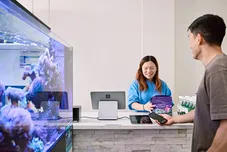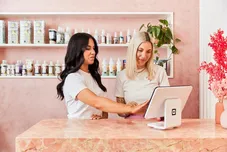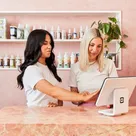This article is for educational purposes and does not constitute legal or medical advice. For specific advice applicable to your business, please contact a professional.
Employees at grocery stores, pharmacies, hardware stores, and other essential retail operations have been among the many dedicated people who are at the frontlines of the COVID-19 pandemic.
To protect employees and customers alike, essential businesses have implemented multiple safety measures based on advice from the Australian and state governments.
Extensive safety protocols will not only help keep your employees healthy but will also build trust between you and your most valuable asset: your customers.
Here are a few safety measures you can put into place today to protect your employees and customers.
Clean and sanitise everything, often
The World Health Organisation says the COVID-19 virus can live on plastic and stainless steel surfaces for up to 72 hours.
To prevent transferring germs, establish a rigorous cleaning protocol for customer-facing and high-touch surfaces. Clean credit card terminals, styluses, and the surrounding area after each customer. If you have the supplies, consider providing wipes to customers and giving them the opportunity to do it themselves to reduce worker exposure.
Cleaning protocols should also extend to employee-only areas. Clean workstations, monitors, keyboards, touchscreens, and related equipment any time a new person uses them. Also, remember to clean shopping carts and baskets after each use. And encourage the use of reusable bags.
In addition to cleaning surfaces, another very important step employees can take is to wash their hands regularly. All employees should scrub their hands with soap and water or use hand sanitiser on numerous occasions throughout the day. Give employees several short breaks to do so.
Encourage contactless payments
Mastercard saw a 40% jump in contactless payments during the first quarter of 2020, which indicates customers want a fast way to check out with fewer touchpoints.
With contactless payments, the credit card or device never leaves the customer’s hands. They simply tap and go. With a point-of-sale system designed with contactless payments in mind, like Square Terminal, businesses of all sizes can create a touch-free checkout environment. Payments that are contactless are safer for your employees and a win for customer service.

Create a barrier
Many chemists and other businesses have installed plexiglass sheeting between cashiers and customers since the virus began. Also called sneeze guards, these clear shields can help to protect employees from virus-containing respiratory droplets while allowing face-to-face interaction.
Even though there’s a thick, clear barrier between customer and cashier, the transaction process remains as smooth as ever. A small cutout window allows card readers to pass through, and barcode scanners can work through the plexiglass.
Create a buffer
It’s recommended that stores should maintain 1.5 metre barriers between customers and employees, where possible. To help customers keep their distance, mark spots on the floor 1.5 metres away from cashiers. Do the same to encourage customers to stay 1.5 metres apart from one another in line. Signage to remind customers to follow the 1.5 metre rule will help reinforce social distancing measures.
To make it easier for people to practice social distancing, you could limit your store capacity to 50%. Depending on where you’re located and the current enforcements in place, you may need to reduce your capacity even more (or increase it). The laws change regularly across Australia, so always check. As people wait to enter, make sure they stay spaced 1.5 metres apart. Consider marking the ground with waiting areas that are 1.5 metres apart to help customers maintain the right distance.
At the front of your store, you should have hand sanitiser readily available to customers, alongside documentation with links where they can check into the state’s Covid-Safe APP, if necessary.Direct customers to different areas of your store as they start shopping to reduce crowding.
Depending on the nature of your business and the severity of COVID-19 in your area, it may make sense to forego face-to-face interactions temporarily and move to online ordering and curbside pickup. If you aren’t selling online yet, you can create an online store that syncs with your inventory to help manage delivery, pickup and shipping options.
Masks may be required
Depending on the severity of COVID-19 and restrictions in place in your state, you may be required to wear a mask as per Government regulations. Wearing face masks and coverings helps protect employees and customers from spreading diseases. Review laws in your city and state to determine what’s required for your business, where necessary.
For the foreseeable future, retailers will need to go the extra mile to protect both employees and customers. Establishing strong infection prevention protocols now is the smart thing to do for your employees and the community at large.
![]()











